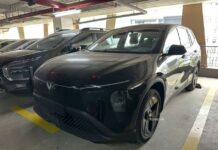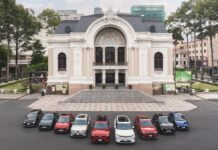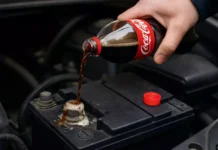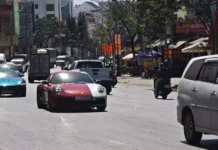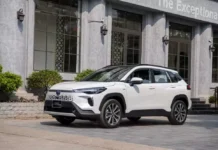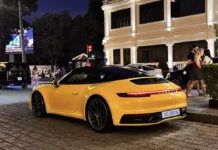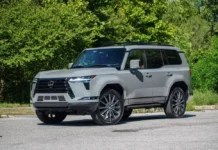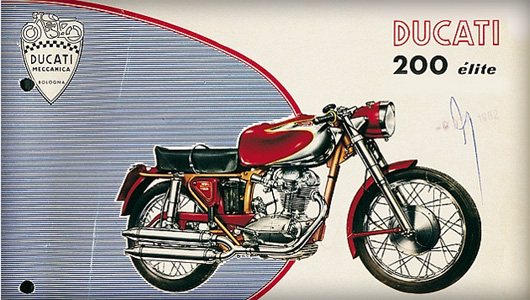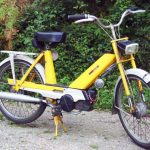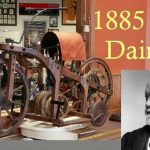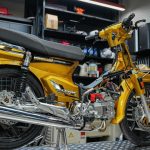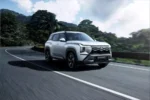Audi has just reached an agreement with partner Investindustrial to acquire motorcycle manufacturer Ducati for $1.1 billion, however, the German carmaker will never be able to buy Ducati’s 80-year history of success.
>> You can comment on this article at http://www.facebook.com/Autodaily
Let’s take a look back at the history of the Italian motorcycle brand to explain why Ducati motorcycles are so popular around the world.
Originating from mechanics
In 1926, the Ducati family and other Bologna investors founded the company Società Radio Brevetti Ducati in Bologna. Their goal was to produce industrial equipment for the growing radio broadcasting sector based on Adriano Ducati’s patent.
The Manens suspension for radio equipment – Ducati’s first “child” – paved the way for a series of other products. The eldest brother, Manens, achieved great success worldwide, allowing Ducati to quickly expand its market and gain the trust of the international industrial community.
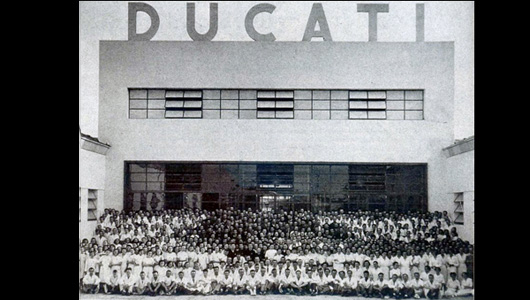 Ducati factory in Borgo Panigale
Ducati factory in Borgo Panigale
In January 1935, the factory was built in Borgo Panigale. The new complex was a modern and ambitious project aimed at establishing an industrial and technological center in Bologna. During this time, Ducati’s market expanded overseas. Many branches and representative offices were established in London, Paris, New York, Sydney, and Caracas to ensure direct service and support to customers in all major markets around the world.
In the 1940s, World War II had a significant impact on Ducati when the factories in Borgo Panigale were destroyed in 1944. Fortunately, the Ducati brothers devoted all their time during the war to research and design new products to introduce to the world market once peace was restored.
In 1946, the Cucciolo – a small auxiliary engine for bicycles – appeared and quickly made waves worldwide. Initially, the Cucciolo was sold in a box kit with a bicycle, but Caproni in Trento (a famous brand in the aviation industry) designed a dedicated frame for this engine based on Capellino’s patent.
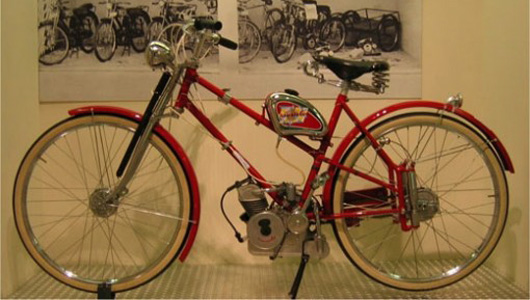 The Cucciolo was sold in a box kit with a bicycle
The Cucciolo was sold in a box kit with a bicycle
Within a short period of time, the Cucciolo transformed into a true mini motorcycle. Thanks to the success of the Cucciolo and its descendants, Ducati became a trusted brand in the mechanical engineering field.
“The first born”
In 1952, the Cruiser 175cc motorcycle with electric starter and automatic gearbox was born. In 1953, Ducati introduced another economical and elegant product with an engine capacity of 98cc upgraded to 125cc.
In 1954, engineer Fabio Taglioni – a legend in the motorcycle world – appeared. As a technical teacher in Imola, Taglioni designed many products with unique technical features and beautiful designs. Taglioni’s pioneering and unconventional designs were popular in racing competitions. After joining Ducati, Taglioni did his best to prove the quality of his self-designed products. Taglioni’s motorcycles participated in many long-distance races such as Milano-Taranto and Giro d’Italia.
At the end of 1956, the four-stroke Tourist 174 accompanied by the Special and Sport models with relatively high speeds (110 – 120 – 135 km/h) was introduced. At the 1957 Milan Salon, these products stood side by side with American models.
In 1958, Elite 200cc – another member of the Ducati family – was produced. The year 1958 also marked the resounding success of the simultaneous opening and closing control system designed by Taglioni in 1955. This system was applied to the 250cc twin-cylinder engine in 1960, following a special order from renowned British racer Mike Hailwood, who needed a super powerful engine.
Leading
In 1964, the 250cc motorcycle was listed in the commercial single-cylinder motorcycle class with a speed of approximately 150 km/h. This was truly a rare figure at the time. This model had a direct influence on all single-cylinder motorcycles in subsequent generations until the Scrambler 250, 350, and 450cc models appeared. The 1964 Mach 250 with a speed over 150 km/h won the hearts of motorcycle enthusiasts everywhere.
In 1968, Ducati delighted motorcycle fans with the introduction of the fairy-tale-like 450 Mark 3D model (speed over 170 km/h). This was the first model to apply the simultaneous opening and closing control system.
In 1972, after achieving significant success in the United States in the early 1960s with the Scrambler models, Ducati planned to apply a similar strategy to the Italian market. And it brought Ducati a huge profit, especially the 450 models equipped with the simultaneous opening and closing control system.
In the late 1960s, there was a boom in the maxi bike segment. Once again, engineer Taglioni helped Ducati hold the winning weapon. On April 23, 1972, Ducati returned to the Imola 200 Miles race with the 750cc twin-cylinder version equipped with the simultaneous opening and closing control system designed by racer Paul Smart and Bruno Spaggiari. True to Ducati’s trust, these two riders finished first and second.
The 750 Supersport model was specially designed for major racing events. In 1978, Mike Hailwood, who grew up with Ducati single-cylinder motorcycles, returned to the Isle of Man Tourist Trophy race and surprised the audience and fans by winning the Formula 1 TT. Accompanying him was the Supersport model with an upgraded capacity of 900cc. To acknowledge Hailwood’s great effort, Ducati designed the limited edition 900 SS Mike Hailwood Replica.
Strong in difficult times
In 1993, Argentine Miguel Galluzzi started to conceive the idea of a Monster. In front of fans, the personal Ducati was born. This motorcycle discarded unnecessary details and represented the leisure category, quickly becoming a legend. Afterward, Ducati continued to introduce the descendants of the 916 in 1994. This was another revolutionary turning point for Ducati in the large-capacity sports motorcycle segment.
With the 916, technology and style, form and symmetrical structure reached their optimal level. Once again, Ducati brought the world of motorcycles a perfect combination of design and function, logic and emotion. The 916 was voted “Motorcycle of the Year” in the world’s most prestigious motorcycle magazines. Accompanying the 916 was the Supermono, one of the most iconic examples of design artistry in motorcycle history, which was also unveiled during this period.
In 1995, despite achieving significant improvements in products and success in races, Ducati still couldn’t escape the financial crisis. Ducati faced a cash shortage due to the failed projects of the Castiglioni brothers within the company.
In 1996, the Texas Pacific Group – a US investment company – took over Ducati with the ability to provide the necessary cash and an international management team for the company. At the same time, the appearance of the ST family provided leverage for Ducati to enter the Sport Touring segment. The new management team, together with the longstanding group of engineers at Ducati, was responsible for developing new products and gradually bringing the company to record-breaking revenues and profits. The resounding success of this period was the Monster Dark – the best-selling motorcycle in Italy in 1998-1999.
Leaving a mark in the new century
In 2000, the MH900e became the first motorcycle to be sold on the Internet. This success paved the way for Ducati to establish the company’s official website, Ducati.com, becoming a prominent name on various websites. After the racing season, Ducati still ranked 9th among manufacturers of supercars, even though Carl “King” Fogarty suffered a disastrous defeat at the end of March. This was also the year Ducati established the first racing school for women and revived the Motogiro d’Italia after many years of hiatus. In mid-July, the company celebrated the production of the 100,000th Monster since 1993.
In 2001, Trou Baliss won the World Superbike Championship on Ducati’s 75th anniversary. Ducati Corse announced plans to participate in the MotoGP World Championship from 2003 with the all-new Desmosedici engine. 2001 was also marked by the departure of Bruno Cavalieri Ducati – the youngest brother of the Ducati family – and Fabio “Dr. T” Taglioni – the father of the current twin-cylinder engine that is widely used today.
 Trou Baliss won the World Superbike Championship
Trou Baliss won the World Superbike Championship
The main event of 2002 was the third Ducati World Week, which lasted for a week. In addition, 2002 set new records for Ducati with the appearance of the 999 model, voted “Most Beautiful Design”. In the World Superbike Championship, Ducati ranked 11th among leading motorcycle manufacturers.
Finally, after 3 years of effort, the Multistrada model set foot on the racetrack in 2003. This was a special year for Ducati Corse when two riders Troy Bayliss and Loris Capirossi returned to the Grand Prix with the all-new Desmosedici V4 engine. The results exceeded expectations as Ducati secured second place in the motorcycle manufacturers’ standings. In the World Superbike Championship, Ducati also won the championship for riders with Neil Hodgson and the top accolade for manufacturers.
In 2004, Ducati’s dream of the SportClassic family became a reality. In the fourth Ducati World Week that year, the company’s success surpassed all previous years. Ducati’s leadership announced the next dream project, the Desmosedici RR – a miniature version of MotoGP.
In November 2005, the announcement of the planned production of the Hypermotard in 2007 took place. In December, Ducati’s shareholders transferred from TPG to Investindustrial in Italy.
 Recent generations of Ducati racing bikes
Recent generations of Ducati racing bikes
In 2006, the Desmosedici RR was launched at the Italian MotoGP. The 1098 superbike, the “successor” of the 999, was also introduced and received the title of “Most Beautiful Design”.
2007 was a year full of events for Ducati, starting with Gabriele Del Torchio becoming the new CEO in May, replacing Federico Minoli. In June, the 2007 Ducati World Week was held at the Misano Adriatico cinema for 4 days, setting a series of new records such as the appearance of 50,000 people and 20,000 motorcycles. Also in the same year, three new models – the 1098, Hypermotard, and Desmosedici RR – were launched and achieved incredible success. Moreover, 2007 will be eternally remembered as the year Ducati won the MotoGP World Championship for the first time in 33 years.
On April 18, 2012, Audi announced its decision to acquire the leading motorcycle brand Ducati for EUR 860 million (equivalent to $1.13 billion). The Ducati brand officially belongs to Audi (a subsidiary of the Volkswagen Group).
Thế Đạt (According to PL&XH)

